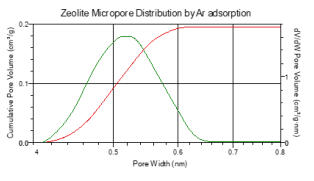




Expertise in the Physical
Characterisation of Materials

MCA Services
Unit 1A Long Barn, North End, Meldreth, Cambridgeshire SG8 6NT UK
01763 262333
© MCA Services




Micropore Analysis by Gas Adsorption
Pore Size Distribution and Pore Volume and Area: Pores < 2nm diameter.
Micropores
are
those
smaller
than
2nm
diameter
and
present
in
a
wide
range
of
materials,
for
example:
zeolites,
MOFs,
ZIFs
and
activated
carbons
and
charcoals.
They
are
fundamentally
important
to
the
functionality
and
performance
of
many
applications:
battery
materials,
catalysts,
adsorbents,
sequestration
and
filter
materials
are
just
a
few
examples.
Micropore
volume
and
area
typically
affect
performance
capacity
and
micropore
size
affects
functionality
and
efficiency.
A
certain
micropore
size
is
often
required
for
a
given
application
to
be
efficient:
consequences
of
micropore
being
too
large
or
small
are
a
loss
of
functionality
and
pore
clogging
/
blocking.
A
full understanding of micro-porous character in terms of volume, area and size distribution is, therefore, required.
At
MCA
Services
we
offer
a
range
of
micropore
analysis
options
using
the
very
latest,
state-of-the-art,
Micromeritics
3Flex
instrument.
Crucially,
dedicated
micropore
analysis
provides
a
full
set
of
pore
size
distribution
data
as
well
as
pore
volume
and
pore
area
data.
These
are
derived
from
specialised
data
reduction
methods
and
models,
such
as
DFT
(Density
Functional
Theory),
NL-DFT
(Non-linear
Density
Functional
Theory)
and
Horvath-Kawazoe.
These
provide
considerably
more
information
(e.g.
pore
size
and
pore
size
distribution)
than
historical statistical methods such as t-plots, alpha-S plots and the Dubinin models, although these can also be applied if required.
Key Information:
•
Micropore size values and micropore size distribution
•
Micropore volume measurement
•
Micropore area value and distribution
•
Choice of micropore only or full isotherm measurement
•
Micropore & mesopore characterisation from full isotherms
•
Data reduction by DFT (Density Functional Theory)
•
Data reduction by NL-DFT (Non-linear Density Functional Theory)
•
BET surface area included in reports
•
Choice of adsorptive: N2, Ar, CO2, H2, O2 or Xe
•
Other adsorbates available on request
•
Comprehensive degassing options
•
Hydrogen adsorption & pressure composition plots
With
many
adsorptives,
analysis
can
be
confined
to
the
micropore
region
or
extended
to
measure
the
full
adsorption
and
desorption
isotherms.
This
extension
provides
micropore
and
mesopore
size,
area
and
volume
distributions
in
a
single
analysis
and
set
of
reports.
The desorption isotherm can provide information on the pore shape present within the mesopore range.
The
Micromeritics
3Flex
is
an
extremely
powerful
instrument
with
cutting
edge
technology
and
software.
A
wealth
of
information
can
be
gained
from
the
comprehensive
data
reduction
software
and
with
our
decades
of
experience
we
are
always
happy
to
determine
the
best
reporting
options
and
pore
models
for
every
sample.
The
combination
of
expertise
and
instrumentation
ensures
that
you always receive the most complete and appropriate data possible.







Expertise in the Physical
Characterisation of Materials
MCA Services
Unit 1A Long Barn, North End,
Meldreth, Cambridgeshire SG8 6NT UK
01763 262333
© MCA Services




Micropore Analysis by Gas Adsorption
Pore Size Distribution and Pore Volume and Area: Pores < 2nm
diameter.
Micropores
are
those
smaller
than
2nm
diameter
and
present
in
a
wide
range
of
materials,
for
example:
zeolites,
MOFs,
ZIFs
and
activated
carbons
and
charcoals.
They
are
fundamentally
important
to
the
functionality
and
performance
of
many
applications:
battery
materials,
catalysts,
adsorbents,
sequestration
and
filter
materials
are
just
a
few
examples.
Micropore
volume
and
area
typically
affect
performance
capacity
and
micropore
size
affects
functionality
and
efficiency.
A
certain
micropore
size
is
often
required
for
a
given
application
to
be
efficient:
consequences
of
micropore
being
too
large
or
small
are
a
loss
of
functionality
and
pore
clogging
/
blocking.
A
full
understanding
of
micro-porous
character
in
terms
of
volume,
area
and
size distribution is, therefore, required.
At
MCA
Services
we
offer
a
range
of
micropore
analysis
options
using
the
very
latest,
state-of-the-art,
Micromeritics
3Flex
instrument.
Crucially,
dedicated
micropore
analysis
provides
a
full
set
of
pore
size
distribution
data
as
well
as
pore
volume
and
pore
area
data.
These
are
derived
from
specialised
data
reduction
methods
and
models,
such
as
DFT
(Density
Functional
Theory),
NL-DFT
(Non-linear
Density
Functional
Theory)
and
Horvath-Kawazoe.
These
provide
considerably
more
information
(e.g.
pore
size
and
pore
size
distribution)
than
historical
statistical
methods
such
as
t-plots,
alpha-S
plots
and
the
Dubinin
models, al
though these can also be applied if required.
Key Information:
•
Micropore size values and micropore size distribution
•
Micropore volume measurement
•
Micropore area value and distribution
•
Choice of micropore only or full isotherm measurement
•
Micropore & mesopore characterisation from full isotherms
•
Data reduction by DFT (Density Functional Theory)
•
Data reduction by NL-DFT (Non-linear Density Functional Theory)
•
BET surface area included in reports
•
Choice of adsorptive: N2, Ar, CO2, H2, O2 or Xe
•
Other adsorbates available on request
•
Comprehensive degassing options
•
Hydrogen adsorption & pressure composition plots
With
many
adsorptives,
analysis
can
be
confined
to
the
micropore
region
or
extended
to
measure
the
full
adsorption
and
desorption
isotherms.
This
extension
provides
micropore
and
mesopore
size,
area
and
volume
distributions
in
a
single
analysis
and
set
of
reports.
The
desorption
isotherm
can
provide
information
on
the
pore
shape
present within the mesopore range.
The
Micromeritics
3Flex
is
an
extremely
powerful
instrument
with
cutting
edge
technology
and
software.
A
wealth
of
information
can
be
gained
from
the
comprehensive
data
reduction
software
and
with
our
decades
of
experience
we
are
always
happy
to
determine
the
best
reporting
options
and
pore
models
for
every
sample.
The
combination
of
expertise
and
instrumentation
ensures
that
you
always
receive
the
most complete a
nd appropriate data possible.


01763262333























